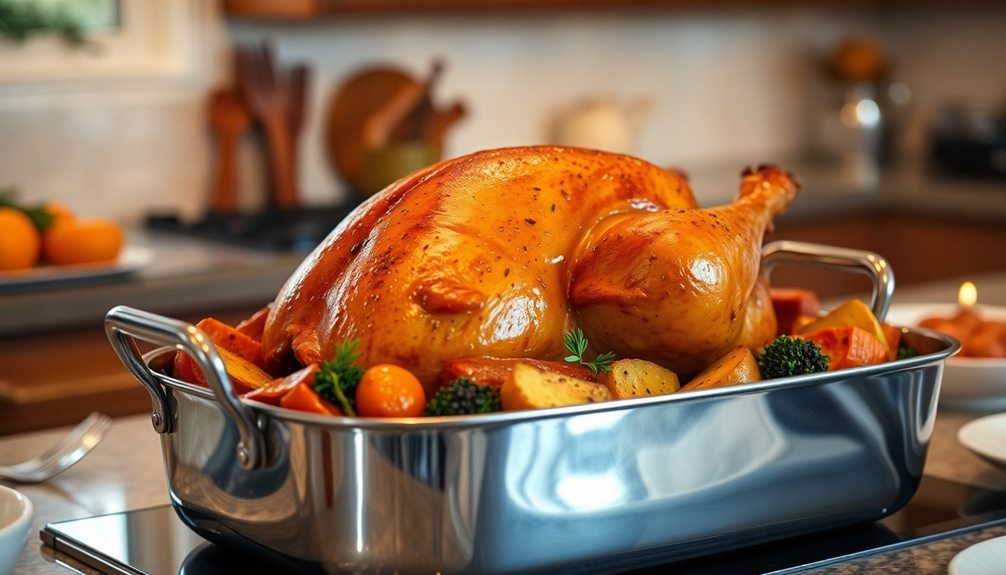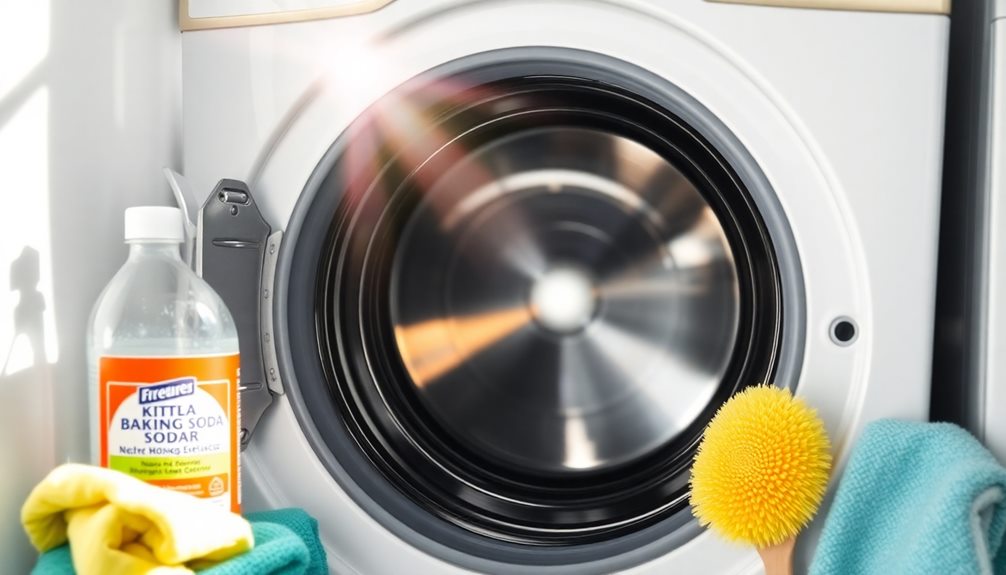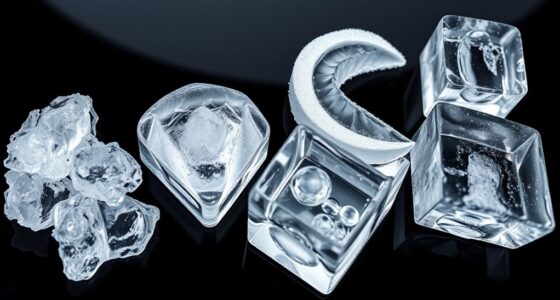Making ice cream with kids is a fun, safe way to enjoy sweet treats together. Supervise closely to prevent spills, burns, or choking hazards, and involve kids in mixing and choosing toppings. Choose allergy-friendly recipes or control ingredients to keep everyone safe. Teach kids safety habits like reading labels and proper storage. If you keep safety front and center, you’ll create delicious memories and help your children learn essential food safety skills—keep going to find out more!
Key Takeaways
- Supervise children closely during mixing, pouring, and appliance use to ensure safety and prevent accidents.
- Choose or prepare allergy-friendly recipes with safe ingredients, and educate kids about allergen awareness.
- Involve kids in fun activities like topping and decorating, while monitoring for choking hazards and utensil safety.
- Store leftover ice cream properly to prevent spoilage, and teach kids about food safety and proper storage habits.
- Use ice cream making as an educational opportunity to teach responsibility, label reading, and safe food handling practices.

Have you ever noticed how much kids love ice cream? It’s one of those treats that instantly brings smiles and excitement. When you’re making ice cream with kids, it’s crucial to prioritize safety and awareness to confirm everyone has a fun, worry-free experience. Parental supervision is key—kids can be clumsy or impatient, so staying close helps prevent accidents, like spills or burns if using a hot fudge sauce or melted chocolate. Keep an eye on them, especially if they’re helping with mixing or pouring ingredients. It’s also a great way to teach responsibility, like washing hands before starting or handling utensils carefully.
Supervise kids closely during ice cream making to ensure safety and fun.
Another critical aspect is allergen awareness. Many store-bought ice creams contain ingredients that can trigger allergies, such as nuts, dairy, or eggs. If your child has known allergies, it’s essential to read labels meticulously or choose allergy-friendly recipes. Making homemade ice cream is an excellent solution because it allows you to control what goes into it. For example, you can substitute dairy with almond or coconut milk or skip nuts altogether. When preparing recipes, double-check all ingredients to avoid cross-contamination. Sharing this knowledge with your kids is also a good idea—teach them to ask about ingredients when buying ice cream from shops, and involve them in choosing allergy-safe options at the store.
Involving kids in the preparation process can make the experience even more enjoyable. Let them help with mixing ingredients, choosing toppings, or decorating the cones. Just remember, during these activities, parental supervision helps keep everything safe. For example, if you’re using a blender or ice cream maker, make sure it’s turned off before letting them handle it. When it comes to toppings like sprinkles, chocolate chips, or fruit, supervise to prevent choking hazards, especially with younger children. Additionally, teach them about allergen awareness—explain why some ingredients are off-limits and how to recognize allergy signs. This education promotes safety and empowers them to make smart choices. Following safety guidelines ensures a fun and healthy experience for everyone involved. Moreover, proper storage of leftover ice cream helps prevent spoilage and maintains quality, which is important for health and safety.
Creating ice cream with kids is not only fun but also an opportunity to instill good habits around food safety and allergen awareness. Keep safety at the forefront by supervising every step, from ingredient prep to eating. Emphasize the importance of reading labels and communicating about allergies. Also, understanding the cycle of breakups in relationships can teach resilience and patience, which are valuable during any collaborative activity. When you incorporate food safety practices, you help ensure that everyone stays safe and healthy. When you combine fun activities with these precautions, you give your kids a memorable experience that’s both delicious and safe. Plus, they’ll learn valuable lessons about food safety that will serve them well in the future. So, gather your ingredients, supervise closely, and enjoy making tasty, allergy-aware ice cream with your little ones!
Frequently Asked Questions
Can Kids Help Make Ice Cream Without Using a Freezer?
Kids can definitely help make ice cream without a freezer using simple mixing techniques. You can prepare no-churn recipes with ingredients like condensed milk and whipped cream, allowing kids to choose their favorite ice cream flavors and mix ingredients safely. They’ll enjoy experimenting with mixing techniques, stirring in fun toppings, and creating personalized treats. It’s a fun, engaging activity that lets them be part of the process while making delicious ice cream.
Are There Allergy-Friendly Ice Cream Recipes for Kids?
Imagine creating a dessert that’s so good, even allergies can’t ruin the fun! You can find plenty of allergy-friendly ice cream recipes for kids, using dairy-free alternatives like coconut or almond milk. Plus, you can top them with allergy-friendly toppings such as fresh fruit or allergen-free sprinkles. These recipes are safe and delicious, ensuring every kid can join in the sweet, chilly adventure without worry.
What Are Safe Food Coloring Options for Children’s Ice Cream?
You’re wondering about safe food coloring options for children’s ice cream. Opt for natural dyes, which are made from vegetable-based coloring. These are a safer alternative to synthetic dyes and reduce allergy risks. You can use beet juice for pink, spinach or spirulina for green, and turmeric for yellow. Always check labels and start with small amounts to guarantee safety and vibrant colors in your kids’ ice cream treats.
How Long Does Homemade Ice Cream Stay Safe to Eat?
Homemade ice cream typically stays safe to eat for about 1 to 2 weeks if you store it properly in an airtight container in the freezer. Keep an eye out for spoilage signs like ice crystals, freezer burn, or an off smell. To confirm safety, try to consume it within this time frame and avoid eating if you notice any unusual changes in texture or odor.
Can Kids Make Dairy-Free or Vegan Ice Cream Recipes?
Yes, kids can definitely make dairy-free or vegan ice cream recipes. You can use dairy free options like coconut milk, almond milk, or cashew cream, and incorporate vegan ingredients such as agave syrup or maple syrup for sweetness. Kids love mixing ingredients and experimenting with flavors, so with supervision, they can enjoy creating tasty, plant-based ice creams that are safe and fun to make at home.
Conclusion
Now that you’ve discovered these simple, fun, and safe ice cream recipes, you’re ready to create your own summer escapades just like Alice chasing the rabbit down the rabbit hole. These treats turn every moment into a delightful adventure, making memories that last. So, grab your ingredients, embrace the joy of baking with your kids, and let your kitchen become Wonderland—where every scoop is a new story waiting to be told.










